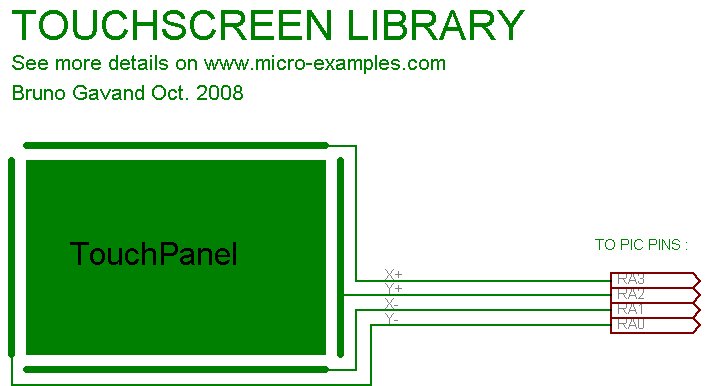Views
Views
From www.micro-examples.com
(Difference between revisions)
(Created page with "Design your own GLCD Touch Clock ==TouchClock : a PIC18 GLCD touchscreen clock== Let me introduce TouchClock to you with this short video clip : {{#ev:youtube|rTRGn16-ml8}} T...") |
|||
| Line 4: | Line 4: | ||
{{#ev:youtube|rTRGn16-ml8}} | {{#ev:youtube|rTRGn16-ml8}} | ||
| − | The idea of this project is to use a graphic LCD with a touchscreen and a built-in sprite editor to design your own clock | + | The idea of this project is to use a graphic LCD with a touchscreen and a built-in sprite editor to design your own clock, and shows how to connect a resistive touchscreen directly to a PIC with no additional hardware. |
| + | |||
| + | This project also includes a ready-to use touchscreen library for PIC | ||
==Circuit Schematic== | ==Circuit Schematic== | ||
| − | [[File: | + | [[File:TouchClock-touchscreen.png]] |
| − | + | This is how the library reads the X raw coordinate of a touch : | |
| − | + | ||
| − | * | + | * X+ and X- are in high Z : RA0 and RA2 are inputs |
| − | + | * Y+ is set to +5V : RA3 is output high | |
| + | * Y- is set to 0V : RA1 is output low | ||
| + | * X+ voltage is read by ADC | ||
| + | * Y+ is set to 0V : RA3 is output low | ||
| + | * Y- is set to 5V: RA1 is output high | ||
| + | * X- voltage is read by ADC and averaged with X+ value, the result is the raw X coordinate. | ||
| + | * The same is then done to read the Y coordinate, please see TSlib.c file in .ZIP file above. | ||
| + | |||
| + | X and Y raw coordinates are then adjusted using calibration coordinates to get X and Y coordinates in pixel. | ||
==C Source code== | ==C Source code== | ||
Revision as of 12:50, 9 February 2012
Design your own GLCD Touch Clock
Contents |
TouchClock : a PIC18 GLCD touchscreen clock
Let me introduce TouchClock to you with this short video clip :
The idea of this project is to use a graphic LCD with a touchscreen and a built-in sprite editor to design your own clock, and shows how to connect a resistive touchscreen directly to a PIC with no additional hardware.
This project also includes a ready-to use touchscreen library for PIC
Circuit Schematic
 This is how the library reads the X raw coordinate of a touch :
This is how the library reads the X raw coordinate of a touch :
- X+ and X- are in high Z : RA0 and RA2 are inputs
- Y+ is set to +5V : RA3 is output high
- Y- is set to 0V : RA1 is output low
- X+ voltage is read by ADC
- Y+ is set to 0V : RA3 is output low
- Y- is set to 5V: RA1 is output high
- X- voltage is read by ADC and averaged with X+ value, the result is the raw X coordinate.
- The same is then done to read the Y coordinate, please see TSlib.c file in .ZIP file above.
X and Y raw coordinates are then adjusted using calibration coordinates to get X and Y coordinates in pixel.
C Source code
Download project
Download LCDscope-project.ZIP file for mikroC : File:LCDscope-project.zip
Includes :
- mikroC PRO project files for PIC18F4620, should work also with most of PIC
- LCDscope C source code
- LCDscope .HEX files
Discussion and Comments
You need JavaScript enabled for viewing comments
| powered by commenterra | Recent comments |